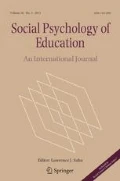Abstract
Parents often become frustrated when their perception of their child’s talent in mathematics differs from that held by the school. Yet for the young child, research suggests parents have a much deeper insight into the interests and talents of their child. Failure to recognize talent can result in lost opportunities for the child as well as a loss to society. This article evaluates the development of an instrument designed to assess parent perceptions of mathematical talent. Parental perceptions and family demographics were collected for third grade students participating in Project M3: Mentoring Mathematical Minds, a research program conducted collaboratively by the University of Connecticut, Northern Kentucky University and Boston University, and for second grade students under consideration for the program. The data were correlated with other identification tools used for the identification of talented second graders for Project M3 to explore a research-based means of parent identification of mathematical talent.
Similar content being viewed by others
References
Andre T., Whigham M., Hendrikson A., Chambers S. (1999). Competencies beliefs, positive affect, and gender stereotypes of elementary students and their parents about science versus other school subjects. Journal of Research in Science Teaching 36, 719–748
Benbow, C. P. (1992). Mathematical talent: Its nature and consequences. In N. Colangelo, S. G. Assouline, & D. L. Ambroson (Eds.), Talent development: Proceeding for the 1991 Henry B. and Jocelyn Wallace national research symposium on talent development (pp. 95–123). Toronto: Trillium Press.
Bennett, J. (1999). The missing link: Connecting parents of mathematically promising students to schools. In L. J. Sheffield (Ed.), Developing mathematically promising students(pp. 163–171). Reston: National Council of Teacher of Mathematics.
Callahan C.M. (2005). Identifying gifted students from underrepresented populations. Theory Into Practice 44(2): 98–104
Carroll S.R. (2003). Mentoring mathematical minds index (3MI). Words & Numbers Research, Torrington
Fennema E., Sherman J.A. (1976). Instruments designed to measure attitudes towards the learning of mathematics by females and males. University of Wisconsin, Madison
Gable R.K., Wolf M.B. (1993). Instrument development in the affective domain: Measuring attitudes & values in corporate & school settings. Kluwer Academic Publishers, Hingham
Gardner H. (1986). Frames of mind: The theory of multiple intelligences. Basic Books, New York
Gavin M.K. (2003). Mathematics characteristics, scales for rating the behavioral characteristics of superior students. Creative Learning Press, Mansfield Center
Getzels J.W., Jackson P. (1962). Creativity and intelligence: Exploration and gifted students. : Wiley, New York
Gustin, W. C. (1985). The development of exceptional research mathematicians. In B. Bloom (Ed.), Developing talent in young people(pp. 270–331). New York: Ballantine Books.
Johns Hopkins University Center for Talent Youth. (2002). Talent search and testing. Retrieved Feb. 28, 2003, http://cty.jhu.edu/ts/ts_faq.html
Koshy V. (2001). Teaching mathematics to able children. David Fulton Publishers, London
Krutetskii V.A. (1976). The psychology of mathematical abilities in schoolchildren. The University of Chicago Press, Chicago
Lee V.E., Burkam D.T. (2002). Inequality at the starting gate. Economic Policy Institute, Washington
Lidza C.S., Macrineb S.L. (2001). An alternative approach to the identification of gifted culturally and linguistically diverse learners: The contribution of dynamic assessment. School Psychology International 22(1): 74–96
Lupkowski-Shoplik A.E., Assouline S.G. (1994). Evidence of extreme mathematical precocity: Case studies of talent youths. Roeper Review 16, 144–151
National Association for Gifted Children (NAGC). (und). Javits program support high-ability learners from under-represented populations. Retrieved August 23, 2007 from http://www.nagc.org/uploadedFiles/PDF/Advocacy_PDFs/Javits%20-%20underrep%20pops.pdf
Pletan M.D., Robinson N.M., Berninger V.W., Abbot R.D. (1995). Parents’ observations of kindergartners who are advance in mathematical reasoning. Journal for the Education of the Gifted 19, 30–44
Project M3. (2007). Year two and year three results. Retrieved August 14, 2007 from http://www.projectm3.org/
Raty H., Snellman L. (2005). On the social fabric of intelligence. Papers on Social Representations 4, 177–195
Rutherford, B., Anderson, B., & Billig, B. (1997). Parent and community involvement in education. Washington: U.S. Department of Education, Office of Educational Research and Improvement.
Stanley J., Lupkowski A.E., Assouline S.G. (1990). Eight considerations for mathematically talented youth. Gifted Child Today 13, 2–4
United States Department of Education (US DOE). (2007). Jacob K. Javits gifted and talented students education program. Retrieved, August 14, 2007 from http://www.ed.gov/programs/javits/index.html
University of Wisconsin. (2004). Wisconsin mathematics, engineering and science talent search. Retrieved July 5, 2004, http://www.mathe.wisc.edu/~talent/
Usiskin, Z. (1999). The mathematically promising and the mathematically gifted. In L. J. Sheffield (Ed.), Developing mathematically promising students(pp. 57–69). Reston: National Council of Teacher of Mathematics.
Usiskin Z. (2000). The development into the mathematically talented. The Journal of Secondary Gifted Education XI, 152–162
VanTassel-Baska, J., & Stambaugh, T. (Eds.). (2007). Overlooked gems: A national perspective on low-income promising learners. Washington: National Association for Gifted Children.
Waxman, B., Robinson, N., & Mukhopadhya, S. (1996). Parents nurturing math-talented young children. Storrs: University of Connecticut, The National Research Center on the Gifted and Talented.
Wertheimer, R. (1999). Definition and identification of mathematical promise. In L. J. Sheffield (Ed.), Developing mathematically promising students(pp. 9–26). Reston, VA: National Council of Teacher of Mathematics.
Wolfe J.A. (1988). Mathematically gifted third graders—a challenge in the classroom. Roeper Review 10, 235–238
Author information
Authors and Affiliations
Corresponding author
Rights and permissions
About this article
Cite this article
Mann, E.L. Parental perceptions of mathematical talent. Soc Psychol Educ 11, 43–57 (2008). https://doi.org/10.1007/s11218-007-9034-y
Received:
Accepted:
Published:
Issue Date:
DOI: https://doi.org/10.1007/s11218-007-9034-y




